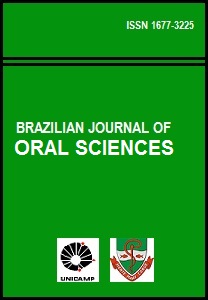Abstract
Aim: The aim of this study was to evaluate the prevalence of dental caries and to estimate the treatment needs, in 4-6-year-old preschool children in a Brazilian town that has recently started a water fluoridation program. Methods: Children (n=127) were randomly selected and examined according to the WHO criteria. The children were examined in schools by calibrated dentists. The intra- and inter-examiner reliability of caries scores showed kappa values ranging from 0.81-0.95 and 0.8, respectively. Mann-Whitney and chisquare tests were used to analyze the results with 5% significance. Results: The mean ± SD dmft was 4.45 ± 3.9 (95%CI 3.76-5.41). The dmft index was mainly composed by the decayed component (4.18 ± 3.4 - 95%CI 3.57-4.79). Only 21.3% of the children were “caries-free” (dmft=0) and 62.2% showed dmfte”3. Fillings and pulp therapy were the most required treatments. Conclusions: The data collected in this study indicate that young children have high caries prevalence and many teeth needing treatment. In addition to the fluoridation program in the public water supply, appropriate health promoting strategies must be implemented to the most vulnerable age groups for controlling dental caries.The Brazilian Journal of Oral Sciences uses the Creative Commons license (CC), thus preserving the integrity of the articles in an open access environment.
Downloads
Download data is not yet available.

